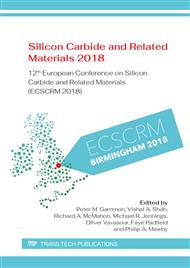p.153
p.157
p.161
p.171
p.175
p.180
p.184
p.189
p.194
Cryogenic Characterization of NH3 Post Oxidation Annealed 4H-SiC Trench MOSFETs
Abstract:
We employed the thermal dielectric relaxation current method (TDRC) for the cryogenic characterization of ammonia (NH3) post oxidation annealed 4H silicon carbide (4H-SiC) trench MOSFETs. We studied differences and similarities between annealing in nitric oxide (NO) and NH3. In NO and NH3 annealed trench MOSFETs, the same type of traps was found near the conduction band edge of 4H-SiC. The TDRC-signal consists of two peaks caused by interface states with a thermal emission barrier of 0.13 eV and near interface traps (NITs) with an emission barrier of approximately 0.3 eV. Significantly more interface traps close to the conduction band edge were found for the NH3 annealed devices compared to the NO annealed ones. Our TDRC results indicate that NH3 post oxidation anneal (POA) affects trap levels in a different way than NO POA.
Info:
Periodical:
Pages:
175-179
Citation:
Online since:
July 2019
Authors:
Keywords:
Price:
Сopyright:
© 2019 Trans Tech Publications Ltd. All Rights Reserved
Share:
Citation:


